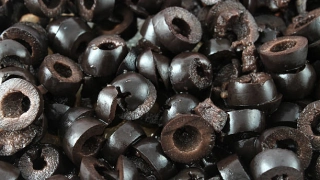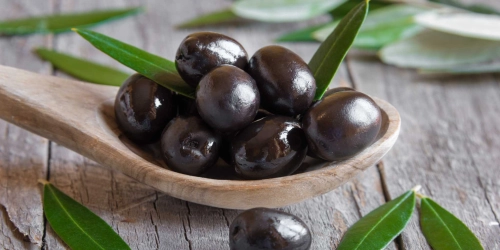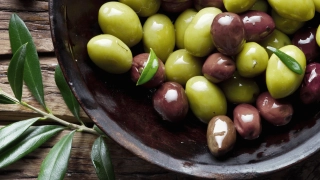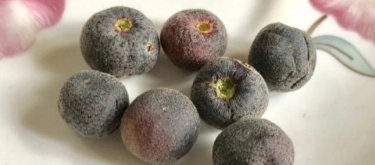Black Olive: Taste Profile, Aroma, Benefits and Health Risks
Black olive is the fully ripened fruit of the olive tree (Olea europaea). Unlike green olives harvested unripe, black olives are picked when mature, resulting in a softer texture and milder flavor. Popular across Mediterranean cuisines, they are used in salads, tapenades, breads, and hot dishes. Their taste profile is gentler, less bitter, and often fruitier than green olives.
Black olives are safe for most people. The primary concern is their sodium content, especially in canned or brined varieties. Individuals with hypertension or kidney conditions should limit consumption. Rarely, olive allergies may occur. Pregnant women can safely consume black olives, but should avoid excessive intake due to salt.
What does Black Olive taste like?

Complete Sensory Description
-
Taste: At first bite, black olives are mild, savory, and less bitter compared to green olives. On the tongue, they present earthy and slightly fruity notes with subtle sweetness. Mid-palate, flavors become rounder, with hints of umami and fermentation. The finish is smooth, leaving a gentle briny aftertaste.
-
Aroma: The retronasal aroma carries earthy, wine-like tones, sometimes with notes of dried fruit or leather depending on curing.
-
Texture: Softer, fleshier, and more yielding than green olives. Some varieties have a melt-in-mouth texture, while oil-cured types are wrinkled and dense.
-
Appearance: Typically dark purple to glossy black, oval or round depending on cultivar, often darker after brining or oil-curing.
In-depth Flavor Analysis
Black olives have reduced levels of oleuropein, the bitter phenolic compound dominant in green olives. As ripening progresses, sugar levels increase and bitterness decreases, creating a smoother taste.
-
Key compounds:
-
Lower oleuropein → less bitterness
-
Increased simple sugars → mild sweetness
-
Lactic acid (fermentation) → tangy undertone
-
Esters and aldehydes → fruity and winey notes
-
-
Processing effects:
-
Flavor levers: Longer curing increases umami and winey depth; shorter brining retains fruitiness.
Varieties and Culinary Applications
-
Kalamata (Greece): Almond-shaped, purple-black, fruity and tangy.
-
Nyon (France): Wrinkled, oil-cured, intense earthy and salty notes.
-
Gaeta (Italy): Small, wrinkled, mild and fruity, often used in pasta sauces.
-
California ripe olives (USA): Mild, soft, often canned, neutral flavor.
Applications: Black olives are used in pizzas, salads (Greek salad, Niçoise), pasta sauces, breads, spreads (tapenade), and braised dishes. They pair well with tomatoes, capers, anchovies, lamb, and strong cheeses.
Selection and Storage
-
Selection: Choose glossy, intact-skinned olives. Oil-cured olives should have an even wrinkled surface without mold. Avoid canned olives with metallic taste or broken skin.
-
Storage: Store unopened jars/cans in a cool place. Once opened, keep in brine, refrigerated, and consume within 2–3 weeks. Oil-cured olives keep longer when covered with olive oil.

Nutritional Insights
Black olives are rich in monounsaturated fats (oleic acid), vitamin E, and polyphenols, but at lower levels than green olives due to ripening. They provide fiber, iron, and copper. They support cardiovascular health, antioxidant defense, and digestion. However, canned types can contain up to 60% of daily sodium intake per serving.
Expert Insights & Culinary Tips
Chefs often use black olives when a dish requires roundness without strong bitterness. For balance, they recommend pairing with acidic components (tomato, lemon) or sharp cheeses (feta, pecorino). Oil-cured black olives add depth to meat braises or roasted vegetables.
Interesting and Curious Facts
In Roman times, black olives were considered more refined than green ones and were served at banquets. In some regions of Spain and Greece, farmers still sun-dry black olives, creating intensely flavored artisanal products.
Harm and Dietary Considerations
-
Excess sodium intake may raise blood pressure.
-
Overconsumption can cause digestive discomfort due to fermentation byproducts.
-
People with kidney issues should moderate intake.
-
Pregnant women should limit salt-heavy canned black olives.
Religious Dietary Considerations
Black olives are permissible in all major religions:
-
Islam: Halal, often used in Middle Eastern cuisine.
-
Judaism: Kosher, frequently included in Jewish Mediterranean dishes.
-
Christianity: Symbolic in rituals, no restrictions.
-
Hinduism & Buddhism: No restrictions.
Final Thoughts & Sensory Journey
Black olives offer a mellow alternative to the sharper green varieties. Their flavor is softer, sometimes fruity, sometimes winey, always briny and comforting. Whether in rustic breads, refined tapenades, or simple salads, they bring an earthy depth that ties together Mediterranean traditions.
Resources
-
Boskou D. Olives and Olive Oil as Functional Foods. Elsevier, 2015. ISBN: 9780128018449
-
Kiritsakis A, Shahidi F. Olive Oil: Chemistry and Technology. AOCS Press, 2017. ISBN: 9781630670851
-
Servili M, Montedoro G. “Phenolic compounds in olive oil: Antioxidant, health and organoleptic activities.” Food Reviews International, 2002. DOI: 10.1081/FRI-120003461
-
Tous J, Ferguson L. Olive Growing. CSIRO Publishing, 2011. ISBN: 9780643103601











